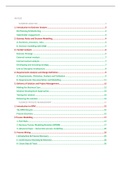Resume
Summary Resume Business Analysis (Master of Business Engineering, KUL)
- Cours
- Business Analysis
- Établissement
- Katholieke Universiteit Leuven (KU Leuven)
Good resume of the course Business Analysis (teached by prof. dr. De Weerdt @KU LEUVEN). Describes the two parts.
[Montrer plus]



